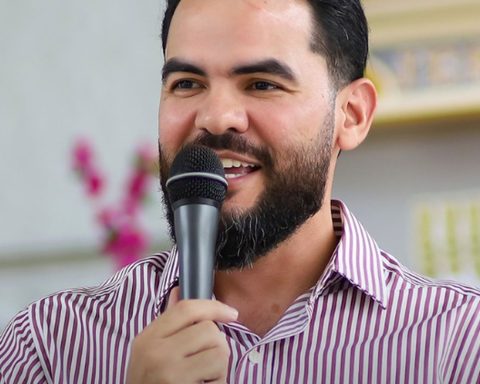An adult human body is made up of 250 grams of salt. In front of the headquarters of the former Department of Political and Social Order (Dops), in the center of Rio de Janeiro, eight 25-kilo bags of salt were loaded and positioned, totaling 200 kilos. More than just salt, the bags have greater symbolism: 800 people.
These are people who fought against the military dictatorship and whose memory and absence are remembered in Julia Cseko’s artistic performance, which was part of the AI-5 Nunca Mais act, held this Friday (13), to remember the signing, on 13 December 1968, from Institutional Act nº 5the most repressive of the 17 institutional acts enacted during the military dictatorship and which marked the beginning of the bloodiest period of the authoritarian regime.
“[A performance é] For us to think about the people we lost, the physicality of the absences we have and everything we also lost during the dictatorship. It was lives, it was sanity. The police only became more brutal, more violent. Corruption has become increasingly endemic,” said the artist.
The event, which brings together artists, people who lived through the dictatorship and who lost loved ones during the period, politicians, activists and human rights defenders, has been held for 11 years in front of Dops and demands that this space become a space of memory for all the repression and torture that occurred right there.
Memory Center
The Central Police building is currently one of the historical and artistic heritage assets of the state of Rio de Janeiro. Today, there is no indication or plaque of the role of this building throughout history. The Dops functioned there, created to ensure and discipline military order in the country. It was used mainly during the Estado Novo and the military dictatorship. It was used as a state apparatus to persecute and torture those who opposed authoritarian regimes.
“We have been fighting for many years to transform this building into a memory center. This is another initiative, always remembering that we don’t want dictatorship, not even AI-5, which was a period where we lost many comrades, we had many disappeared. In addition to those who fought against the dictatorship, many segments were vilely affected by unacceptable cruelty. So, dictatorship never again, AI-5 never again”, said one of the organizers of the event Vera Vital Brasil, from Coletivo RJ Memória, Verdade, Justiça, Reparação e Democracia.
Historian Paulo Cesar Azevedo Ribeiro, who is also part of the Collective, highlights the importance of transforming the building into a space of memory.
“This was the scene of arrests of famous people, of Graciliano Ramos [um dos mais importantes autores da literatura brasileira]by Nise da Silveira [psiquiatra brasileira reconhecida por revolucionar o tratamento mental]. It is, after all, a symbolic place”, he recalls.
“Here is 600 square meters. Imagine, in the center of the city of Rio de Janeiro, a center of memory and culture, with workshops for young people to learn, with cinema, with art, to store what is known. Rio de Janeiro deserves this. We don’t have a memory center for the struggles against repression”, argues the historian.
Not to repeat
According to the National Truth Commission, 50,000 people were arrested in 1964 alone, the year of the military coup, and many of them suffered torture. The commission also identified at least 434 people killed or missing by dictatorial forces.
For the Secretary of Human Rights of the Communist Party of Brazil, Dilceia Quintela, preserving memory is important so that history does not repeat itself.
“Every year, always on December 13th, we come here to remember, to not let ‘that unfortunate page in our history’ be forgotten, as Chico Buarque would say. And in the year that marks the 60th anniversary of the coup, with coup plotters walking around, right? With what happened on January 8, 2023, in Brasília, with everything that was discovered, with the attempted coup still there in 2022, after the elections. We cannot let it go unnoticed”, he warns.
In November, the Federal Police launched an operation to dismantle a criminal organization responsible for planning a coup d’état to prevent the inauguration of President Luiz Inácio Lula da Silva after the 2022 election. plan that included the assassination of Lula and the vice-president, Geraldo Alckmin, was printed at Palácio do Planalto, in November of that year.
Add salt
Artist Julia Cseko was born in the United States, because her father, composer Luiz Carlos Cseko, was forced to leave the country to avoid persecution by the dictatorship. Currently, seeing that the dictatorship and the crimes committed during the period have little repercussion in North America, she uses the funding from a grant to create works of art with this theme, like the one performed this Friday.
“We are in a very complicated historical moment. They want to amnesty people who tried to carry out a coup. I don’t think there’s any amnesty for these people. This is important to say too. And this is the symbol of being together, in solidarity, resisting, continuing this work of resistance, continuing the work of fighting for human rights, with the collectives. It’s a very beautiful collaboration. And that. Come on, let’s put salt here”, he calls.















